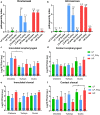Variable impact of the hemagglutinin polybasic cleavage site on virulence and pathogenesis of avian influenza H7N7 virus in chickens, turkeys and ducks
- PMID: 31399610
- PMCID: PMC6689016
- DOI: 10.1038/s41598-019-47938-3
Variable impact of the hemagglutinin polybasic cleavage site on virulence and pathogenesis of avian influenza H7N7 virus in chickens, turkeys and ducks
Abstract
Avian influenza viruses (AIV) are classified into 16 hemagglutinin (HA; H1-H16) and 9 neuraminidase (NA; N1-N9) subtypes. All AIV are low pathogenic (LP) in birds, but subtypes H5 and H7 AIV can evolve into highly pathogenic (HP) forms. In the last two decades evolution of HPAIV H7 from LPAIV has been frequently reported. However, little is known about the pathogenesis and evolution of HP H7 from LP ancestors particularly, in non-chicken hosts. In 2015, both LP and HP H7N7 AIV were isolated from chickens in two neighbouring farms in Germany. Here, the virulence of these isogenic H7N7 LP, HP and LP virus carrying a polybasic HA cleavage site (HACS) from HP (designated LP-Poly) was studied in chickens, turkeys and different duck breeds. The LP precursor was avirulent in all birds. In contrast, all inoculated and contact chickens and turkeys died after infection with HP. HP infected Pekin and Mallard ducks remained clinically healthy, while Muscovy ducks exhibited moderate depression and excreted viruses at significantly higher amounts. The polybasic HACS increased virulence in a species-specific manner with intravenous pathogenicity indices of 3.0, 1.9 and 0.2 in chickens, turkeys and Muscovy ducks, respectively. Infection of endothelial cells was only observed in chickens. In summary, Pekin and Mallard were more resistant to HPAIV H7N7 than chickens, turkeys and Muscovy ducks. The polybasic HACS was the main determinant for virulence and endotheliotropism of HPAIV H7N7 in chickens, whereas other viral and/or host factors play an essential role in virulence and pathogenesis in turkeys and ducks.
Conflict of interest statement
The authors declare no competing interests.
Figures







Similar articles
-
Evidence for Different Virulence Determinants and Host Response after Infection of Turkeys and Chickens with Highly Pathogenic H7N1 Avian Influenza Virus.J Virol. 2022 Sep 14;96(17):e0099422. doi: 10.1128/jvi.00994-22. Epub 2022 Aug 22. J Virol. 2022. PMID: 35993736 Free PMC article.
-
Insertion of Basic Amino Acids in the Hemagglutinin Cleavage Site of H4N2 Avian Influenza Virus (AIV)-Reduced Virus Fitness in Chickens is Restored by Reassortment with Highly Pathogenic H5N1 AIV.Int J Mol Sci. 2020 Mar 28;21(7):2353. doi: 10.3390/ijms21072353. Int J Mol Sci. 2020. PMID: 32231159 Free PMC article.
-
Virulence of three European highly pathogenic H7N1 and H7N7 avian influenza viruses in Pekin and Muscovy ducks.BMC Vet Res. 2019 May 10;15(1):142. doi: 10.1186/s12917-019-1899-4. BMC Vet Res. 2019. PMID: 31077209 Free PMC article.
-
Ducks: the "Trojan horses" of H5N1 influenza.Influenza Other Respir Viruses. 2009 Jul;3(4):121-8. doi: 10.1111/j.1750-2659.2009.00084.x. Influenza Other Respir Viruses. 2009. PMID: 19627369 Free PMC article. Review.
-
Genetic changes that accompanied shifts of low pathogenic avian influenza viruses toward higher pathogenicity in poultry.Virulence. 2013 Aug 15;4(6):441-52. doi: 10.4161/viru.25710. Epub 2013 Jul 16. Virulence. 2013. PMID: 23863606 Free PMC article. Review.
Cited by
-
Epidemiology and phylodynamics of multiple clades of H5N1 circulating in domestic duck farms in different production systems in Bangladesh.Front Public Health. 2023 Jul 6;11:1168613. doi: 10.3389/fpubh.2023.1168613. eCollection 2023. Front Public Health. 2023. PMID: 37483933 Free PMC article.
-
Preferential Selection and Contribution of Non-Structural Protein 1 (NS1) to the Efficient Transmission of Panzootic Avian Influenza H5N8 Virus Clades 2.3.4.4A and B in Chickens and Ducks.J Virol. 2021 Aug 25;95(18):e0044521. doi: 10.1128/JVI.00445-21. Epub 2021 Aug 25. J Virol. 2021. PMID: 34160261 Free PMC article.
-
Evolution of H7N9 highly pathogenic avian influenza virus in the context of vaccination.Emerg Microbes Infect. 2024 Dec;13(1):2343912. doi: 10.1080/22221751.2024.2343912. Epub 2024 Apr 29. Emerg Microbes Infect. 2024. PMID: 38629574 Free PMC article.
-
Bioluminescent detection of viral surface proteins using branched multivalent protein switches.RSC Chem Biol. 2023 Nov 23;5(2):148-157. doi: 10.1039/d3cb00164d. eCollection 2024 Feb 7. RSC Chem Biol. 2023. PMID: 38333197 Free PMC article.
-
Annotating Spike Protein Polymorphic Amino Acids of Variants of SARS-CoV-2, Including Omicron.Biochem Res Int. 2022 Apr 11;2022:2164749. doi: 10.1155/2022/2164749. eCollection 2022. Biochem Res Int. 2022. PMID: 35450296 Free PMC article.
References
-
- Bosch FX, Garten W, Klenk HD, Rott R. Proteolytic Cleavage of Influenza-Virus Hemagglutinins - Primary Structure of the Connecting Peptide between Ha1 and Ha2 Determines Proteolytic Cleavability and Pathogenicity of Avian Influenza-Viruses. Virology. 1981;113:725–735. doi: 10.1016/0042-6822(81)90201-4. - DOI - PubMed
Publication types
MeSH terms
Substances
LinkOut - more resources
Full Text Sources
Medical
Research Materials
Miscellaneous

